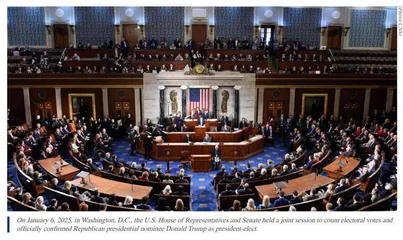2024 US General Election and Changes in its Party Politics
作者: Xie Tao

The US 2024 general election ended with the Republican Party winning the presidential, House and Senate elections at the same time. In the presidential election, the Republican Party not only won more popular votes in over 90% counties than in the 2020 general election, but also won seven highly contested swing States with greater edges. This also marks the first time since 2004 that the Republican Party has won a relative majority of popular votes in the presidential election. The “red wave” successfully pulled off by the Republican Party with Trump at the helm in the 2024 general election broke the “blue wall” that the Democratic Party struggled to build up, and once again sent Trump and the highly “Trumpized” Republican Party to the center of US politics.
The results of the 2024 general election not only reflect the changing balance of power in American political parties, but also show that the voter camp realignment of the two parties has been further solidified. Trump, winner of the election, has full control over the Republican Party, marking the completion of “Trumpization” of the Republican Party. The Democratic Party, which lost the election, drifted away from the working class, thus losing its “soul” since Roosevelt’s New Deal. The end of the general election in 2024 indicates the beginning of a new stage of change in American party politics. Whether the two parties can effectively transform themselves against US democracy decline will not only influence the evolution of domestic politics in the United States, but also affect the future interaction between itself and the rest of the world.
Trump’s Return and the Change of Balance of Power between the Two Parties
The performance of the Republican Party in the 2024 general election, especially Trump’s strong performance in the presidential election, undoubtedly beat expectations of most observers and polls. With the “better-than-expected” performance of the Republican Party, Trump went through a gorgeous turn from being entangled in lawsuits to being in power, becoming the second president in American history to serve nonconsecutive terms. In the Senate election, the Republican Party gained 4 more seats and regained control of the Senate again since 2018. In the House of Representatives election, although the Republicans lost two seats, they still maintained the majority position with a slight advantage. Therefore, the Republican Party can be called a big winner in the 2024 general election, and since Trump was first elected in 2016, it has once again achieved the so-called “unified government” with a Republican “trifecta”.
As far as the presidential election is concerned, the Republican Party has indeed formed a strong suppression over the Democrats. The so-called “red shift” has appeared in almost all the 50 states and Washington, D.C. Even in the “deep blue states” like New York and New Jersey, the Republican Party has achieved more than 10% vote growth. The Democrats, on the other hand, “have achieved nothing but losses” as they not only failed to “turn blue” any state, but also lost hundreds of thousands of votes in big cities such as New York and LA.
On the other hand, there has been no fundamental change in the balance of power between the two parties in Congress. Looking back at the comparative changes in the seats of the two parties in Congress since Roosevelt’s New Deal, it is not hard to find that the number of seats owned by the two parties is getting ever closer. The gap between the seats of the two parties in the House has dropped from a peak of 246 to less than 10 in recent years, and the gap in the Senate has gradually narrowed from a record 60 in 1936 to less than 10 in recent years. It can be therefore considered that the balance of power between the two parties in Congress has already changed from the old normal of disparity in strength to a new normal of “even game”, and the so-called “insecure majority” has become a new feature of the change of US party politics. The balance of power has undoubtedly intensified the power struggle between the two parties. As the single-digit change of seats can alter the control of Congress, the two parties must go all-out to win every election, and at the same time constantly strengthen the differences between themselves and their opponents in values and policy positions. In other words, the narrowing of the seat gap between the two parties has actually deepened the polarization between the pair and made the party struggle ever more intensive.
Compared with the presidential election, the Republican Party did not win an “overwhelming victory” over the Democratic Party in the congressional election. After the election, the seat gap between the two in the Senate and the House is less than ten. Such a small seat gap means that the Republicans have not won overwhelmingly, and the Democrats have not lost miserably. The basic balance of power between the two in Congress has not been upset, and it is highly likely that the majority and the minority Party will swap positions again when the next election comes.